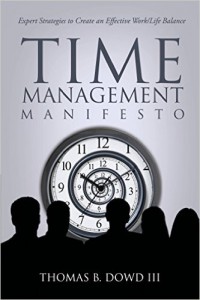What if you could accomplish more in a forty-hour week than your current fifty, sixty, or seventy-hour work week? What if your success was simply a matter of working smarter, not harder? Good time management and organizational skills are a must for successful professionals, yet employees mistakenly take pride in saying that their plates are full and that they’re burning the midnight oil. Understanding the basic concepts found in Thomas B. Dowd III’s fourth book, Time Management Manifesto: Expert Strategies to Create an Effective Work/Life Balance, will get readers thinking about solutions, not excuses, to build the right foundation.
- There are no secrets to time management. Be acutely aware of the priorities in your life.
- Realize that technology is both a blessing and a curse. Whatever efficiency is gained by some smart phone app gets lost with the unproductive hours on social media. Technology may support your time management efforts, but it is not the solution.
- Stop multi-tasking. It is proven to increase the time to complete all tasks. Be laser focused on one task at a time.
It’s not hard to build effective time-management habits. When individuals strengthen their commitments and practices relating to time management and organizational skills, they will understand that they have more control of their day than they realize. Proven success comes with solid routines, increased flexibility, and an improved ability to adjust on the fly. These skills allow us to successfully reduce stress, increase goal achievement, and ensure that we sleep better at night knowing that our life is under control—even while dealing with the unexpected interruptions that continuously come throughout each day.
The following 5 strategies teach readers to more effectively manage personal and professional lives that are bleeding together.
1. Do the least amount of work you can do in a day: We often have exhaustively long to-do lists that are impossible to complete. Ask yourself, what is the least amount of work you can do in that day and still walk out the door satisfied? The shorter list is what you should use—the I-can’t-leave-until-it’s-done list. Everything else is simply adding value.
2. Pull vs. push: Is your to-do list so long that you’re constantly pushing it to the next day? Each day at 5:00 PM, see what you have to do tomorrow and make adjustments. Do the same thing each Friday at 5:00 PM and look at the next week. On the 25th of each month, look at the next four weeks. Using the least amount of work you can do in a day concept and strategically seeing what’s ahead, you learn the power of pulling in tasks from future days, weeks, and months vs. constantly pushing them.
3. Minimize interruptions: Have dedicated time to turn off your phone, stop looking at emails, and close your door. Each time we’re interrupted, we invest a significant amount of time and energy to get back to the original thought. The concentrated effort is not only refreshing, it’s productive.
4. Touch it once: Turn off your email previews. It is simply another interruption. Build in time in the morning, mid-day, and afternoon to go through your emails in blocks. When you see an email, you need to do something with it. Your only options are: unsubscribe if it’s spam, delete it, read it and delete it, read it and save it for future reference, or schedule it on your calendar to work on it at another time. Leaving it in your inbox is not an option. A new client tried this and his email dropped from 18,000 to less than 100 in a week. Touching it once also relates to filing (electronic or paper is not relevant).
5. Sleep well: Keep a pad of paper and a pen next to your nightstand, and simply wait for the ideas to flow. When random thoughts wake you, write them down immediately. This has a couple of benefits. First, you won’t forget. Also, you’ll minimize your tossing and turning and sleep better. What’s this have to do with time management? Everything. When you are well-rested you are naturally more productive and mentally prepared.
Time Management Manifesto details: Book, 6.0 x 9.0, 88 pages $15.95; ISBN: 978-1-503017-47-4, eBook $4.99, Business & Money/Skills/Time Management, Self-help/Personal Growth/Success. This intentionally short read written specifically for busy professionals has consistently received positive reviews, including: “Wow! This powerful, practical book shows you how to get your time and your life under control—immediately.”— Brian Tracy, author of Ultimate Sales Success.
details: Book, 6.0 x 9.0, 88 pages $15.95; ISBN: 978-1-503017-47-4, eBook $4.99, Business & Money/Skills/Time Management, Self-help/Personal Growth/Success. This intentionally short read written specifically for busy professionals has consistently received positive reviews, including: “Wow! This powerful, practical book shows you how to get your time and your life under control—immediately.”— Brian Tracy, author of Ultimate Sales Success.
Find a Home-Based Business to Start-Up >>> Hundreds of Business Listings.

















































